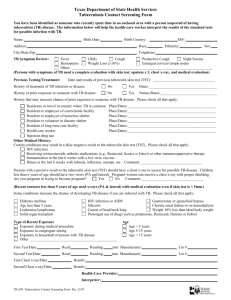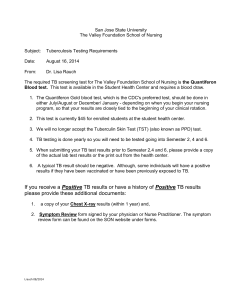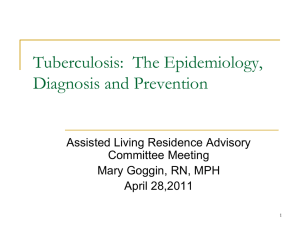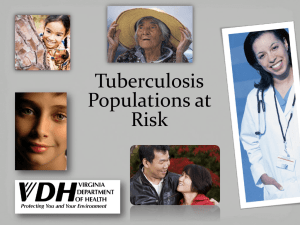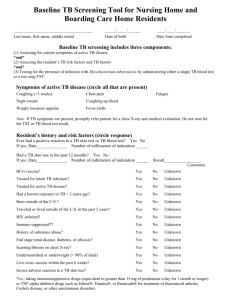TB education for the community health nurse
advertisement
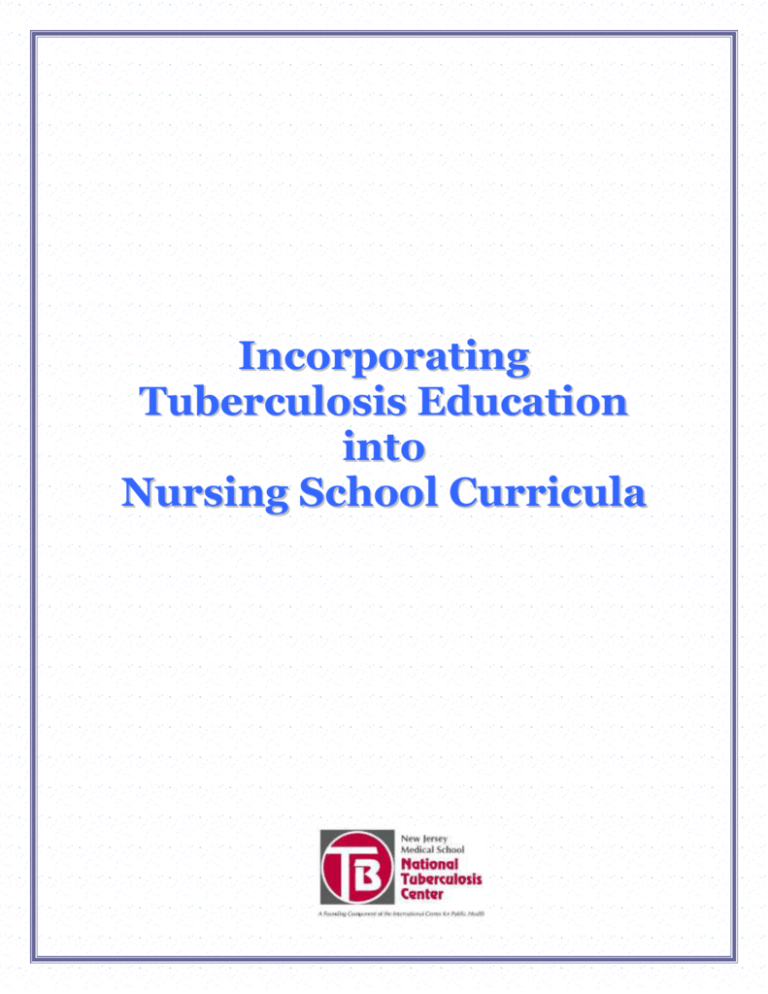
Incorporating Tuberculosis Education into Nursing School Curricula Part One: Faculty Guide Preface Objectives History of TB in the United States Pathogenesis and Transmission of TB Pathophysiology of TB Infectiousness Common sites of TB disease Identifying Persons at Risk for developing TB Disease Targeted testing Diagnosis of TB Clinical manifestations of TB Tuberculin testing - Mantoux skin test - QuantiFERON-TB test Chest x-ray Sputum examination Treatment of Latent TB Infection (LTBI) Treatment of TB Disease Basic principles Drug regimens Monitoring for adverse reactions Drug resistance Appendices Appendix 1: Procedure for administering TST Appendix 2: Methods to improve adherence 2 Part Two: Learning Modules Fundamentals of Tuberculosis for Community and Public Health Nurses Objectives Powerpoint slide presentation Case study and discussion questions Suggested readings Suggested clinical experiences Fundamentals of Tuberculosis Nursing in the Hospitalized Adult Patient Objectives Powerpoint slide presentation Case study and discussion questions Suggested readings Suggested clinical experiences Fundamentals of Tuberculosis Nursing in Children and Adolescents Objectives Powerpoint slide presentation Case study and discussion questions Suggested readings Suggested clinical experiences Understanding Pathophysiology of Tuberculosis Objectives Powerpoint slide presentation Suggested readings Pharmacology of Anti-Tuberculosis Medications Objectives Powerpoint slide presentation Suggested readings 3 Preface This resource, Incorporating TB Education into Nursing School Curricula was developed to address a void in TB education in nursing curricula and to ensure that nurses entering the workforce have an understanding of latent TB infection (LTBI) and TB disease, including their impact on the delivery of care to patients and families. This resource was a collaborative venture between the New Jersey Medical School National Tuberculosis Center and the Boston University School of Medicine Pulmonary Center. In consultation with a diverse group of practicing nursing faculty, we have designed a standardized program for presenting TB education that can be easily adapted for use in various didactic courses throughout the curriculum. This resource begins with a faculty guide that provides an overview of TB, its pathogenesis and transmission, diagnostic criteria, and treatment. The guide is designed to provide the faculty member with a summary of the most up-to-date information. It is meant to be a supplement to existing curricula, focusing on TB as a prototype for an infectious disease course of study. The overview is followed by course-specific modules for nursing of the child and adolescent, nursing of the hospitalized adult, and community/public health nursing. Each module contains a PowerPoint® slide presentation to supplement lecture material, as well as case studies and discussion questions. In addition, there are modules for use in pharmacology and pathophysiology courses. It is our intent that this program will facilitate and encourage the development of critical thinking skills in the undergraduate nursing student through the application of TB as an infectious disease prototype. We are optimistic that this format will stimulate student and faculty interest in the topic and encourage the inclusion of relevant and current information about TB into the curriculum on a regular basis in the absence of a TB specialist. 4 Objectives The aim of this guide is to meet the following objectives: Familiarize nursing school faculty with knowledge of current guidelines in testing and treating persons with latent TB infection and disease Encourage nursing school curriculum committees to incorporate the information contained in this program into various levels of nursing education Provide faculty with the most current resources for implementing teaching strategies specifically aimed at the nursing management and treatment of the patient and family affected by TB 5 History of TB in the United States Despite the obvious decrease of TB cases in the United States, mandatory reporting indicates the continued occurrence of TB disease, as well as drugresistant TB. An estimated 10 to 15 million persons in the U.S. are infected with Mycobacterium tuberculosis. From 1953 to 1984, reported cases of TB decreased by approximately 5.6% each year From 1985 to 1992, reported cases increased by 20% 25,313 cases were reported in 1993 Since 1993, cases have steadily declined in most areas of the country but increased in other areas where there are patients who are foreign-born, have HIV infection, drug-exposed, or are underserved From 1990 to 1992, multidrug-resistant (MDR) TB outbreaks occurred in seven hospitals in New York, New Jersey, Florida, other states and in other countries. These outbreaks resulted in TB infection, TB disease, and death In 2003, there were 14,874 reported cases of TB in the U.S. - 53% were among foreign-born persons The following are major factors that contributed to the rise of TB: HIV epidemic Increased immigration from countries with a high-burden of TB Transmission of TB in congregate settings (e.g., correctional facilities, longterm care) Deterioration of the public healthcare infrastructure Efforts to control TB through the prompt identification and treatment of persons with infectious TB can reduce the number of newly infected persons. Pathogenesis and Transmission of TB Pathophysiology of TB TB is an infectious disease caused by Mycobacterium tuberculosis. It is an airborne infection spread by minute, invisible particles, called droplet nuclei, that are harbored in the respiratory secretions of people with active tuberculosis Droplet nuclei are tiny particles that remain suspended in air and travel directly to the alveoli on inspiration. It generally takes 5 to 200 organisms implanted in the alveoli to cause the infection 6 Tubercle bacilli incite a chronic inflammatory response in the lung known as granulomatous inflammation Cell-mediated immunity and hypersensitivity reactions contribute to the disease activity. On entering the alveoli, the bacilli are surrounded and engulfed by macrophages. This is followed by the development of single gray-white circumscribed granulomatous lesion called Ghon’s focus that contains the bacilli, modified macrophages, and other immune cells Within 2 to 3 weeks the Ghon’s focus undergoes soft (cheese-like) necrosis. This occurs at about the time that the tuberculin test becomes positive, suggesting that the necrosis is caused by the cell-mediated hypersensitivity immune response. During this same time, tubercle bacilli drain along the lymph channels to the tracheobronchial lymph nodes of the affected lung, causing caseous granuloma Primary TB occurs in a person with no previous contact with the TB bacilli. Initially, a person may be asymptomatic, but may only have a positive tuberculin skin test (TST) result. The condition may progress to primary TB, resulting in extensive destruction of lung tissue Hematogenous dissemination, caused by erosion of blood vessels, gives rise to lesions in almost any organ but particularly the brain, meninges, liver, kidney, and bone marrow Results from previously healed primary lesion usually because of reinfection Results in situations of impaired body defense mechanism Cavities may form in the lungs at sizes up to 15 cm in diameter. Pleural effusion and tuberculous empyema are common as the disease progresses 5% of persons infected with M. tuberculosis will develop TB disease in the first 1 to 2 years after infection. 5% of infected persons will develop TB disease at some later point in their lives Infectiousness Infectiousness is directly related to the number of inhaled tubercle bacilli expelled into the air, the length or duration of exposure, and the environment in which exposure took place. Patients with pulmonary or laryngeal TB should be considered infectious if they are: Coughing, undergoing cough-inducing or aerosol-generating procedures, or have sputum smears containing acid-fast bacilli (AFB) Not receiving therapy, having just started therapy, or having poor clinical or bacteriological response to therapy 7 Patients are generally NOT considered infectious if they meet ALL these criteria: Have received appropriate therapy for 2 to 3 weeks Have a favorable clinical response to therapy Have negative results from sputum specimens collected on 3 consecutive days Common Sites of TB Disease Although TB may be found in most systems of the body, the most common sites are: Lungs (85% of all cases) Pleura Central nervous system - TB meningitis Genitourinary system - kidney Bones and joints Disseminated (miliary TB) Lymphatics – TB scrofula Identifying Persons at Risk for Developing TB Disease The risk of progressing from TB infection to disease is the greatest in the first 1 to 2 years after exposure, therefore, those with known or suspected exposure to TB should be skin tested. TB risk factors include: Recent, prolonged exposure to a person with infectious TB Recent converters (those with an increase of 10 mm induration or more in the size of the TST reaction within a 2-year period) Persons who have immigrated from areas of the world with high rates of TB Children younger than 5 years of age who have a positive TST result In addition, there are groups of people who have high rates of transmission and are therefore more likely to have been recently infected, including persons who are: 8 HIV infected Injection drug users Homeless Residing or working with others who are at high risk for TB, in facilities or institutions such as: Hospitals Homeless shelters Correctional facilities Nursing homes Residential homes for those with HIV Substance-abuse treatment centers Also at risk are persons with certain clinical conditions that increase the likelihood of progression from LTBI to active TB disease once infected. These conditions include: HIV infection Injection drug use Radiographic evidence of prior, healed TB Weight loss of ≥10% of ideal body weight Other medical conditions such as diabetes mellitus, silicosis, cancer of the head and neck, hematologic and reticuloendothelial diseases, end-stage renal disease, intestinal bypass or gastrectomy, chronic malabsorption syndromes, prolonged corticosteroid therapy, and other immunosuppressive therapies (such as Remicade® (infliximab) used for Crohn’s disease and arthritis) Targeted testing Targeted testing for LTBI is a procedure used to identify persons at highest risk for developing TB who would benefit by treatment. Targeted testing of high-risk populations for TB infection and treatment for infection are crucial to achieving the nation’s goal of eliminating TB, however: Not everyone should be routinely tested for TB Testing should target only those groups who are at higher risk than the general population for TB exposure, infection, or disease Testing should be done ONLY if there is an intention to treat LTBI 9 The following groups should be targeted for TST: • • • • • • • • Persons with or at-risk for HIV infection Close contacts of persons with infectious TB Persons with certain medical conditions Persons who inject drugs Foreign-born persons from areas where TB is common Medically underserved, low-income populations Residents of congregate settings Locally identified, high-prevalence groups Diagnosis of TB For an accurate diagnosis of TB to be made, the primary healthcare provider should consult with an expert—one with experience in the disease process and with competencies regarding specimen collection and TST reading and interpretation. In addition, a qualified and trained physician should evaluate the chest radiograph. The diagnosis of TB is made based on the results of the following: A complete medical and psychosocial history and physical examination (certain findings, though not conclusive, may be suggestive of the diagnosis such as rales in the upper, posterior portion of the chest, lymphadenopathy, weight loss, and fever) TST Chest x-ray Sputum examination including AFB smears, cultures to determine presence of organisms, and drug sensitivity studies Clinical Manifestations of TB TB is often diagnosed based on a group of symptoms rather than one major presentation. The patient may present with one or more of the symptoms listed below or may be completely asymptomatic: 10 Productive prolonged cough* Chest pain Hemoptysis Fever* Chills Night sweats* Easy fatigability Loss of appetite Weight loss (more than 10% body weight over a short period of time) * Earliest and most commonly described symptoms of pulmonary TB. Tuberculin Testing Mantoux Tuberculin Skin Test The Mantoux tuberculin skin test (TST) is the preferred method for testing for TB infection, in which 0.1 mL of 5-TU purified protein derivative (PPD) solution is injected intradermally into the volar surface of the forearm using a 27-gauge needle with a tuberculin syringe. Administering and reading the TST Careful attention must be paid to administering the tuberculin skin test. (See Appendix 1). Classifying tuberculin reactions Induration >5 mm is positive in: Persons known to have or suspected of having HIV infection Close contacts of a person with infectious TB Persons who have a CXR suggestive of previous TB Persons who inject drugs (if HIV status unknown) Persons who are immunosuppressed Organ transplant recipients Induration >10 mm is positive in: Persons with certain medical conditions that affect immunity Persons who inject drugs (if HIV-negative) Foreign-born persons from areas where TB is common Medically underserved, low-income populations Residents of long-term care facilities Children younger than 4 years of age Locally identified high-prevalence groups 11 Induration >15 mm is positive in: All persons with no known risk factors for TB Note: For persons with occupational exposure to TB, the appropriate cutoff depends on: Individual risk factors for TB The prevalence of TB in the facility or place of employment Two step TST If If If If the the the the first test is positive, consider the person infected first test is negative, give second test 1 to 3 weeks later second test is positive, consider the person infected second test is negative, consider the person uninfected Key points Conversion is defined as an increase in the size of the tuberculin skin test reaction of at least 10 mm following repeat tuberculin testing and is due to new bacterial infection. This is due to new mycobacterial infection. False-negative TST reactions may be caused by: Very young age (<6 months old) Overwhelming TB disease Receipt of live virus vaccinations, such as MMR, within past 6 weeks Improper storage of tuberculin test solution Improper administration technique Test should be done on only those in whom therapy for LTBI is indicated A negative reaction to the TST does not exclude the diagnosis of TB, especially for patients with severe TB illness or infection with HIV Severe adverse reactions are rare. Local allergic reactions occur in 2% to 3% of those tested, and are not related to the actual tuberculin result Strongly positive reactions with vesiculation should be covered with a dry dressing to prevent scratching and infection. Apply cold compresses for soothing effect Bacille Calmette-Guerin (BCG) vaccine is currently used in many parts of the world to protect infants and children from TB disease, especially military TB. 12 There is no reliable method of distinguishing tuberculin reactions caused by BCG from those caused by TB infection As a TB prevention strategy in the United States BCG vaccination is limited because its effectiveness in preventing infectious forms of TB is uncertain Evaluate all BCG-vaccinated persons who have a positive TST result for treatment of LTBI TB history of BCG vaccine is NOT a contraindication for TST. TST reactivity caused by BCG vaccine generally wanes with the passage of time. Periodic skin testing may prolong reactivity in vaccinated persons. Reactions >20 mm induration are unlikely to be caused by BCG If more than 5 years have elapsed since administration of BCG vaccine, a positive TST reaction is most likely a result of TB infection QuantiFERON - TB Test (QFT) FDA-approved (2001) blood test to diagnosis LTBI Advantages include: requires only 1 office visit, does not cause “boosting,” useful in baseline and serial screening Disadvantages include: specimen must be processed within 12 hours, not for use in high risk populations, lack of clinical experience with the test Chest x-ray An anterior-posterior x-ray of the chest is standard. CXR should be done in patients with positive TST results or when the index of suspicion is high in the absence of a negative test An abnormal CXR cannot solely confirm the diagnosis of TB, but can be used in conjunction with other diagnostic indicators Key point Children’s CXR should be read by a pediatric radiologist Sputum examination 13 Collection This procedure should be supervised by a healthcare provider to ensure that the specimen is a product of lung secretions (not saliva). Patients may have to be coached in the proper way of expectorating. During the specimen collection, patients may produce an aerosol that can be hazardous to the healthcare provider so precautions must be taken. Collect 3 specimens 8 to 24 hours apart Spontaneous morning is sputum is more desirable than induced specimens Ideally, collect sputum before drug therapy is initiated. Do not delay starting therapy if unable to collect sputum Specimens must be labeled and refrigerated until transported to the lab Smears Therapy can be started once smear results are obtained (usually within 24 hours) Strongly consider the diagnosis of TB in patients with smears containing AFB Other mycobacterium (M. avium, M. africanum) can cause positive smears Use follow-up smear examinations to assess patient’s infectiousness and response to therapy, as well as a benchmark for hospital discharge and/or return to work or school (the number of AFB on the smear should decrease once treatment has started) Cultures Cultures remain the gold standard for confirming diagnosis of TB Culture all specimens, even if smear is negative Initial drug isolate should be used to determine drug susceptibility Cultures may take up to 12 weeks for results Quicker results can be obtained using genotyping techniques (limited availability) 14 Treatment of Latent TB Infection (LTBI) It is estimated that 10 to 15 million people in the United States have LTBI. In 2003, more than half of cases of TB in the U.S. occurred in foreign-born individuals. Identifying and treating potential cases of active TB will advance the goal of elimination of the disease. Treatment of LTBI includes: Daily INH therapy for 9 months OR daily RIF for 4 months Monitor patients for signs and symptoms of: Hepatitis Neurotoxicity Note: RIF may lead to discoloration of contact lenses, interact with oral contraceptives and methadone, and may turn body secretions an orange color. It is not recommended for persons taking protease inhibitors for treatment of HIV infection. Treatment of TB Disease Basic principles Provide safest, most effective therapy in shortest time Use multiple drugs to which organisms are susceptible Never add a single drug to a failing regimen Ensure adherence to therapy (see Appendix 3) Conduct initial screening that may include blood work, and vision/hearing evaluation Drug regimens Four drugs are included in the initial phase to prevent the development of multidrug resistance. Once the drug susceptibility results are known, the regimens are adjusted. Four drugs in the initial phase of treatment – approximately 2 months Isoniazid (INH) Rifampin (RIF) Pyrazinamide (PZA) Ethambutol (EMB)* * In children, EMB should only be added to the regimen in areas where drug resistance is high or if source case may have drug-resistant TB 15 Key points Initial drug regimen will be altered based on results of cultures and information about source case During the continuation phase (the remaining 4 months of a 6-month regimen), PZA and EMB may be discontinued if sensitivities are available and specimen is pan sensitive Fixed-dose combinations of medications are available INH Bactericidal, relatively non-toxic, inexpensive, and easily administered May reduce the incidence of the disease up to 90% Interacts with phenytoin (Dilantin) Major adverse effect: hepatitis Other common complaints include GI distress Rash Occasional peripheral neuropathy 10-15 mg/kg pediatric dose 5-15 mg/kg adult dose - 300 mg QD (max) RIF Bactericidal, relatively non-toxic, and easily administered Interacts with oral contraceptive pills (OCP), seizure medications, anticoagulants, and methadone Major adverse effect: hepatitis Other common complaints include GI distress Rash Bleeding problems Flu-like symptoms 10-20 mg/kg pediatric dose 10 mg/kg adult dose - 600 mg QD (max) PZA Bactericidal Interacts with OCP, seizure medications, anticoagulants, methadone, and more Major adverse effect: Hepatitis Other common complaints include GI distress Rash 16 Joint aches Hyperuricemia 20-25 mg/kg pediatric and adult dose EMB Bacteriostatic Interacts with OCP, seizure medications, anticoagulants, methadone, and more Major adverse effect: optic neuritis - Test color discrimination using Ishihara test - Test baseline visual acuity using Snellen eye chart 15-25 mg/kg pediatric and adult dose Fluoroquinolones Currently second-line drugs In-vitro activity against TB Levofloxacin, moxifloxacin, and gatifloxacin Major adverse effects: leukopenia, elevated creatinine Monitoring for Adverse Reactions The nurse should assess the patient monthly or more frequently for adherence to the prescribed regimen and signs or symptoms of TB disease, as well as for adverse effects of TB medications. Instruct patients taking INH, RIF, and PZA to report immediately the following symptoms of hepatitis: Nausea Loss of appetite Vomiting Persistently dark urine Yellowish skin Malaise Unexplained fever for 3 or more days Abdominal tenderness (specifically right upper quadrant pain) Change in visual acuity and/or color discrimination 17 Drug resistance Patients on long-term drug therapy may develop primary or secondary resistance. Primary resistance - index case is infected with drug-resistant organisms and then infects another susceptible host with same drug-resistant organisms Secondary resistance - inadequate treatment has occurred because: The patient has not taken the anti-TB therapy as prescribed There are physical malabsorption problems There has been improper prescription of drugs and/or dosages 18 APPENDICES Appendix 1: Procedure for administering the TST • • • • • • • • • Use intradermal Mantoux test with 0.1 ml of 5-TU PPD tuberculin Do not recap, bend, or break needles, or remove needles from syringes Follow universal precautions for infection control Interpret reaction 48 to 72 hours after injection Measure only transverse diameter of induration Record results in millimeters Negative readings must be documented as 00 mm of induration Reading must be done by trained healthcare provider Anergy testing is not recommended 19 Appendix 2: Methods to improve adherence Non-adherence to TB treatment is a major problem in TB control. In 1994, it was estimated that approximately 14% of patients who started treatment did not complete a full course. Directly Observed Therapy (DOT) DOT is defined as the administration and/or observation of a patient taking/ingesting medication in accordance with the physician’s orders. DOT is considered when patients who are non-adherent, are suspected or diagnosed with TB of the respiratory tract, have HIV infection, reactivation, or substance abuse • A DOT plan should be discussed with the patient and agreed upon by both patient and healthcare provider. It must be documented in the patient’s chart, and reviewed at frequent intervals • Consider DOT for all patients; it is the best way to ensure adherence • DOT should be used with all intermittent regimens • DOT can lead to significant reductions in relapse and acquired drug resistance • Use DOT with other measures to promote adherence Other Measures to Promote Adherence • • • • • • • Develop an individualized treatment plan for each patient (case management) Involve patient in decision-making whenever possible Healthcare workers must have increased awareness of cultural issues that may be barriers to adherence Work with outreach staff from same cultural and linguistic background as patient, if possible Educate patient about TB, medication dosage, and possible adverse reactions Use incentives and enablers to remove barriers to adherence Facilitate access to health and social services 20
